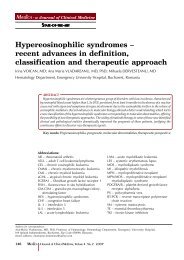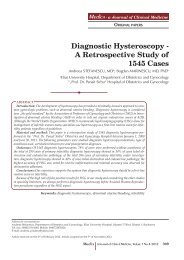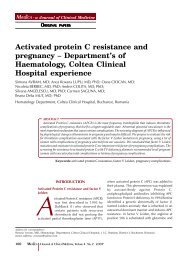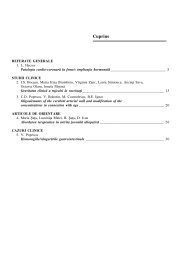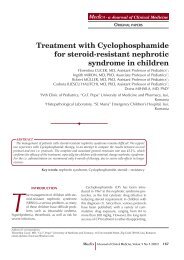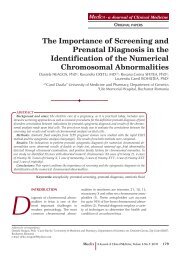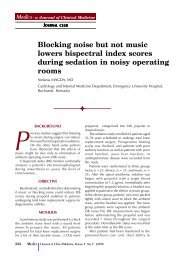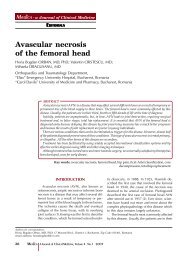Early Repolarization Syndrome - MÃDICA - a Journal of Clinical ...
Early Repolarization Syndrome - MÃDICA - a Journal of Clinical ...
Early Repolarization Syndrome - MÃDICA - a Journal of Clinical ...
You also want an ePaper? Increase the reach of your titles
YUMPU automatically turns print PDFs into web optimized ePapers that Google loves.
EARLY REPOLARIZATION SYNDROME- TO BE OR NOT TO BE BENIGN<br />
end diastolic volume and better diastolic performance).<br />
In 2011 a paper evaluating cardiac<br />
function parameters and synchrony revealed in<br />
a group <strong>of</strong> 18 young subjects with inferior ERS<br />
that subjects with inferolateral ERS have significant<br />
intraventricular dyssynchrony due to a<br />
pro longed electromechanical activation into<br />
the segments with ERS. These subtle changes,<br />
su g gesting particular properties <strong>of</strong> the action<br />
potential in these segments, are not associated<br />
with any other structural or functional changes,<br />
however, on a long-term, this regional dyssynchrony<br />
might affect LV function and might induce<br />
arrhythmias (15).<br />
Integrating all <strong>of</strong> the above is it or is it not<br />
benign and why is it so important to know? First<br />
<strong>of</strong> all, we should take in consideration that sudden<br />
cardiac death is not at all a neglectable<br />
cause <strong>of</strong> death; the majority <strong>of</strong> such sudden<br />
cardiac arrests are caused by ventricular tachyarrhythmias,<br />
which occur in persons without<br />
structural heart disease in 6 to 14% <strong>of</strong> cases, so<br />
any tool <strong>of</strong> identifying population at risk is important.<br />
Probably being the devil advocate,<br />
taking in account that a) ST elevation during<br />
myocardial infarction in women is less higher<br />
than in men, and women have a four fold lower<br />
risk <strong>of</strong> cardiac death than men, b) sodium<br />
channels blockers used to unmask Brugada<br />
syndrome generate a ST elevation similar to<br />
that in inferior myocardial infarction, c) Ito channel<br />
incriminated in ERS is more prominent in<br />
men has a greater heterogeneity in the inferior<br />
wall, I think arrhythmogenic potential <strong>of</strong> ERS<br />
should not be underestimated (2-4,16). Of course,<br />
there are opinions in favor <strong>of</strong> its benign<br />
na ture, which emphasize the fact that the results<br />
<strong>of</strong> the available studies can not be generalized<br />
as they involved selected population, but<br />
let’s accept that there is no single large clinical<br />
trial certifying ERS benign prognostic. Until<br />
prospective population data are available,<br />
careful attention should be paid to ERS especially<br />
in case idiopathic arrhythmias or family<br />
history <strong>of</strong> unexplained sudden death. Holter<br />
monitoring or telemetry, eventually electrophysiological<br />
studies are useful tools for evaluating<br />
individuals with ERS on ECG and syncope<br />
(17-19). No specific treatment is available for<br />
this entity, taking in consideration that it pathological<br />
nature is not well established. As Haissaguerre<br />
pointed out in 2008, it is difficult to<br />
identify the ERS population at risk <strong>of</strong> VF. There<br />
is a speculation that Brugada syndrome treatment<br />
(quinidinde) may be an option for inferolateral<br />
ERS and that research in order to identify<br />
outward current blockers drugs would be<br />
an option for treatment for those at risk. Clinicians<br />
should also have in mind the possible relation<br />
with Brugada syndrome, Na channels<br />
blockers being a useful tool for unmasking the<br />
last one (20-22).<br />
Not knowing what exactly causes this phenomenon,<br />
it is difficult to declare its benign nature.<br />
Even though no data is available, it is <strong>of</strong><br />
great interest if inferolateral ERS may be an individual<br />
syndrome differentiated from anterior<br />
ERS, with another pathogeny and therefore different<br />
prognosis (23).<br />
I would like to end considering that as in<br />
war, when you do not know well your enemy,<br />
it is better to maintain a constant precaution<br />
and to look for as many information as possible<br />
in order to avoid defeat.<br />
REFERENCES<br />
1. Miyazaki S, Shah AJ, Haissaguere M<br />
– <strong>Early</strong> repolarization syndrome: a new<br />
electrical disorder associated with<br />
sudden cardiac death. Circ J 2010; 74:<br />
2039-2044<br />
2. Gussak I, George S, Bojovic B, et al.<br />
– ECG Phenomena <strong>of</strong> the <strong>Early</strong><br />
Ventricular <strong>Repolarization</strong> in the 21<br />
Century. Indian Pacing Electrophysiol J.<br />
2008; 8: 149-157<br />
3. Stern S – <strong>Clinical</strong> Aspects <strong>of</strong> the <strong>Early</strong><br />
<strong>Repolarization</strong> <strong>Syndrome</strong>: A 2011<br />
Update. Ann Noninvasive Electrocardiol<br />
2011;16:192–195<br />
4. Antzelevitch C, Yan G – J wave<br />
syndromes. Heart Rhythm. 2010; 7:<br />
549-58.<br />
5. Gussak I, Antzelevich C, Hammil S, et<br />
al. – Cardiac repolarization-bridging<br />
basic and clinical science. Humana<br />
Press. 2003;111-127; 407-427<br />
6. Boineau J – The early repolarization<br />
variant—an electrocardiographic<br />
enigma with both QRS and J-STT<br />
anomalies. J Electrocard, 2007; 40: 3.e1–<br />
3.e10<br />
7. Gourraud JB, Chatel S, Le Scouarnec S<br />
et al. – <strong>Early</strong> <strong>Repolarization</strong> <strong>Syndrome</strong>:<br />
Autosomal Dominant Malignant Form<br />
in Large French Families. Circ J, 2010;<br />
122: A20987<br />
8. Haïssaguerre M, Derval N, Sacher F, et<br />
al. – Sudden cardiac arrest associated<br />
with early repolarization. N Engl J Med.<br />
2008; 358: 2016-23<br />
9. Rosso R, Kogan E, Belhassen B, et al.<br />
– J-point elevation in survivors <strong>of</strong><br />
primary ventricular fibrillation and<br />
matched control subjects: incidence and<br />
218 Maedica A <strong>Journal</strong> <strong>of</strong> <strong>Clinical</strong> Medicine, Volume 6 No.3 2011




